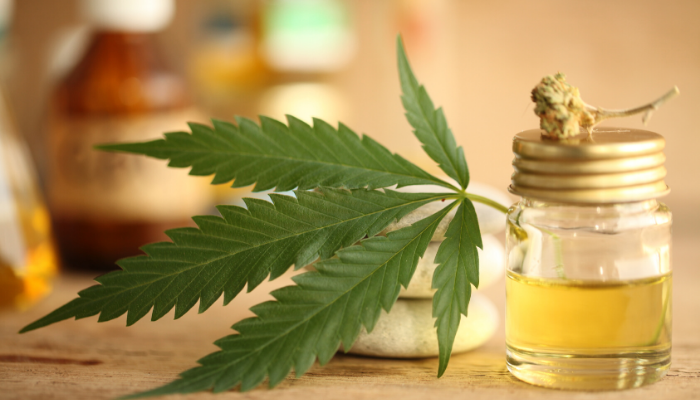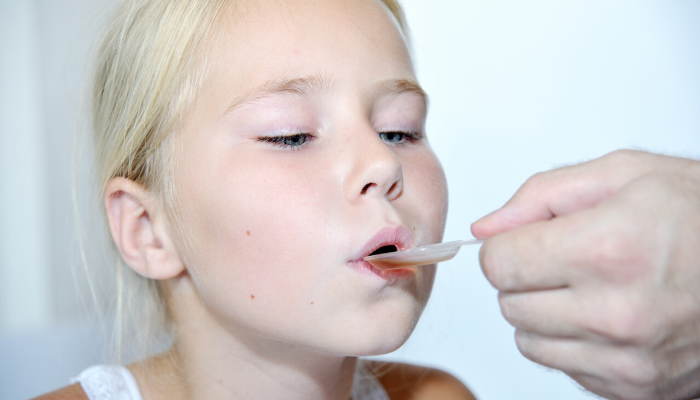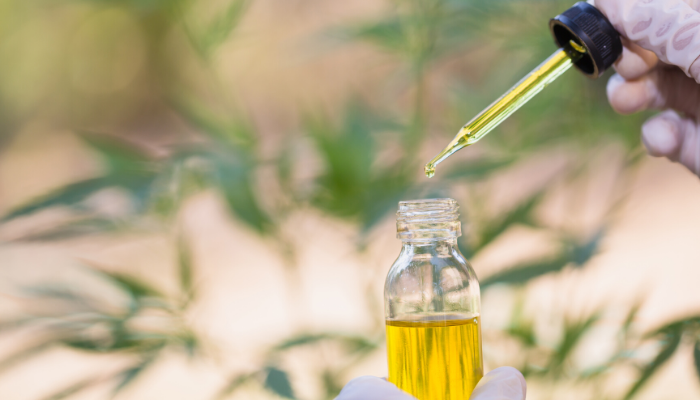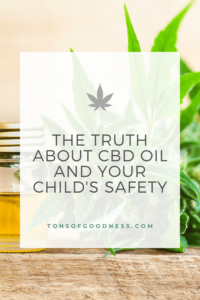The Dangers of CBD Oil: How to Keep Your Child Safe
Disclosure: Some of the links in this article are affiliate links, which means that if you purchase through those links I will receive a small commission. For example, as Amazon Associate, I earn from qualifying purchases. If you decide to use these links, thank you so much for your support!
CBD oil is becoming a popular option for a variety of health conditions. However, is CBD oil a safe option for kids?
Due to its popularity, the number of CBD products has exploded in the last year or two. I’m sure you have seen them…CBD gummies, lotions, coffee, pet treats, patches, etc. They are everywhere!
While I support natural and alternative treatments, I always do my research before using a new product. So, I was originally looking into whether CBD oil is really the miracle product that people claim it to be…or whether it’s just a trendy placebo.
What I found along the way is that many people are giving CBD oil and products to their kids. Of course, I found this to be alarming since CBD oil is a relatively new product on the market. And from what I’ve found, it is a highly unregulated product. In this post I will explain how CBD works in your body along with the possible benefits and risks of CBD oil.
Because as parents and caregivers, we need to take a closer look – and think twice – before buying in to a trend that will affect our kids.
What is CBD oil?
Cannabidiol (CBD) is an extract from the flowers, stalks, and seeds of cannibus plants. Full spectrum CBD oil contains all of the compounds that are found naturally in the plant, including cannabinoids (with very small amounts of THC), terpenes and essential oils.
CBD has become especially popular because of their low THC levels. This means that you can experience the therapeutic benefits without the intoxication or “high” of marijuana.

How Does CBD Oil Work?
CBD interacts with our body by effecting the regulatory system called the endocannabinoid system (ECS) (6). The main function of the endocannabinoid system is to maintain your body’s balance in response to changes in the environment.
Researchers have found that the endocannabinoid system is involved in a wide variety of processes. Some of these processes include pain, memory, mood, appetite, stress, sleep, metabolism, immune function, and reproductive function (11).
The results from a 2015 study (12) indicate that while CBD does not have direct interactions with ECS receptors, it does have the ability to regulate signaling systems and to enhance endocannabinoid levels.
Possible Benefits of CBD Oil for Kids

Seizure Disorders
The only condition that has been extensively researched in regards to CBD effectiveness and safety is epilepsy. In June of 2018 the FDA approved a purified CBD oral solution called Epidiolex (7). This solution is found to provide major reductions in total seizure frequency for patients with specific types of epilepsy including Lennox-Gastaut syndrome (LGS) and Dravet syndrome (DS) in patients 2 years of age and older.
Anxiety and Sleep
Parents have reported giving their children CBD oil on a daily basis to help with anxiety. However, the research on its effectiveness in treating anxiety is very limited.
There is only one case study to date in which the use of CBD oil was effective in reducing anxiety and improving sleep in a young girl with posttraumatic stress disorder (13). A larger case series completed with adults concluded that CBD displays promise as a tool for reducing anxiety (14). It was indicated that randomized and controlled trials are needed to provide definitive clinical guidance.
- For non-medication strategies to help you child with anxiety, please refer to Anxiety in Children: The Ultimate Guide to Helping Your Child Cope by Tina Williamson.
- For strategies to help you child with sleep, please refer to Proven Ways To Improve Your Child’s Sleep Hygiene.
Autism Spectrum Disorder
Autism Spectrum Disorder (ASD) is a neurological disorder characterized by persistent deficits in social communication, restricted and repetitive patterns of behavior, interests, or activities and often intellectual disabilities.
Parents of children with autism have reported that CBD oil has improved their child’s symptoms.
The research shows that this is promising. For example, an observational study concluded that cannabis as a treatment for ASD patients appears to be an effective option to relieve symptoms. These symptoms included: seizures, tics, depression, restlessness and rage attacks (12). It is important to note, however, that the treatment was based on cannabis oil containing 30% CBD and 1.5% THC. Many studies that I have reviewed indicate that the presence of THC is needed in order for CBD to be effective.
In addition, a review of pre-clinical data indicates that CBD oil seems to be a candidate for the treatment of ASD. They indicated, however, that further data showing efficacy and safety of cannabinoid treatment in ASD patients is needed (6).
- A collection of resources that provides parents and professionals with information for understanding autism spectrum disorders is available from OCALI and Autism Speaks.
Attention-Deficit Hyperactivity Disorder
Another condition of interest is Attention-Deficit Hyperactivity Disorder (ADHD). While data has shown that endogenous cannabinoids (cannabinoids made by your body) may play a role in ADHD (10), studies have not demonstrated effectiveness or safety for CBD when it comes to ADHD management.
According to CHADD (Children and Adults with Attention-Deficit/Hyperactivity Disorder), “there haven’t been any studies on the use of CBD oil in children; neither have there been studies on long-term effects. So while some people are using it and have shared their results publicly, researchers and medical professionals have not found evidence that it is an effective treatment for ADHD. The research does not show that CBD oil works for ADHD management”. (9)
- For non-medication strategies for children with ADHD, please read ADHD and School: A Toolkit for Parents.
The Dangers of CBD Oil

1. Risk of Toxicity
CBD has psychoactive properties – meaning that it is a substance that affects the brain. Overexposure to CBD products can be toxic to young children.
According to the American Academy of Pediatrics (AAP), the number of calls to poison centers reporting CBD concerns have dramatically increased in just two years (6).
This may be associated with the increase in the number of products sold with CBD, such as oil, lotion, food, drinks, and pills. Gummies that look like candy should especially be out of reach of children.
Symptoms of CBD Toxicity
Symptoms of CBD toxicity include extreme confusion, anxiety, paranoia, panic, fast heart rate, delusions or hallucinations, increased blood pressure and severe nausea or vomiting.
Since cannabis-based products can be toxic to young children, the American Academy of Pediatrics and the FDA reminds parents to keep these products out of reach of children. The FDA urges parents to seek medical treatment if they suspect their child has accidentally consumed a cannabis-based product.
2. CBD Oil Products are Unregulated
There are no FDA-approved drug products that contain CBD other than Epidiolex. In addition, CBD oil and products do not meet the requirements to be considered a dietary supplement.
Unfortunately, this means that CBD oil and CBD products are not regulated. Therefore, products can contain more or less CBD or THC than labeled. And they may be contaminated with other ingredients.
A 2017 survey reported that of 84 online CBD and hemp oil products examined, only 26 were accurately labeled for CBD and THC content. CBD was often over-labeled while THC was under-labeled (3).
Why is this important? Because the use of untested and poor quality CBD products can have unpredictable and unintended consequences. For example, there are documented cases of pediatric THC intoxication related to CBD product ingestion. These cases are likely due to this variation in products, indicating the need for more regulation of the market (6).
3. Disruption During Development
Endogenous cannabinoids (cannabinoids made by your body) play vital roles in a baby’s development. During their prenatal development, endocannabinoids are crucial for brain development. In addition, after your child’s birth endocannabinoids help stimulate the process of suckling and promote appetite, teaching newborns the vital process of getting nutrients.
Some have argued that more cannabinoids from CBD will then be better for your baby. However, the opposite is actually true.
A study completed by in 2008 found that manipulation of the endocannabinoid system (ECS), by administering cannabinoids, alters the delicate balance of the baby’s ESC. This causes prenatal stress and may interfere with the ability of the fetus and newborn baby to cope with stress (8). In addition, CBD oil can interfere with your baby’s brain development and lead to later behavioral problems.
4. Potential Liver Injury
During its review of the application for Epidiolex (a purified form of CBD) the FDA identified the potential for liver injury. In clinical studies, almost 16% of people taking the drug had high blood levels of liver enzymes (7). High levels of liver enzymes in the blood can mean there is a problem with the liver.
These are serious risks that a physician can be monitor. However, it is less clear how these risks might be managed when CBD is used far more widely, without medical supervision.
5. Reproductive System Damage
I know that you’re probably not thinking about your child’s reproductive future. However, a 2018 study aimed to assess the effects of chronic CBD exposure on the male reproductive system (5). These results indicated that chronic CBD exposure was associated with changes in the male reproductive system (decrease in testosterone, sperm abnormalities), suggesting its reproductive toxicity.
6. Fatigue
Another potential risk of CBD oil is fatigue. Specifically, during the clinical trials of Epidiolex, drowsiness was a common side effect (7). Up to 25% of people taking the drug felt unusually sleepy. About 12% of people taking Epidiolex had fatigue (low energy levels). And between 3% and 6% of people taking the drug felt sedated.
These side effects could lead to your child feeling sleepy while at school, they may experience loss of coordination, and may have trouble thinking clearly.
7. Medication Interactions
CBD can reduce or increase the effects of certain medications. This is because CBD inhibits liver enzymes that work to metabolize medications as well as eliminating toxins from the body (4).
For this reason, it’s important to talk to your child’s doctor before using CBD.
How to Purchase a Quality CBD Oil

If you have considered the risks and would still like to use CBD oil with your child, consult with your child’s physician first. It is also crucial to use a high-quality CBD oil. Here is what to look for before you purchase:
- Where is it Grown – The source of CBD is crucial because hemp plants easily absorb everything that is present in the ground where it was farmed and cultivated. Look for the USDA organic certification and USDA organic handler’s certification.
- Ask for the Certificate of Analysis (COA) – Quality companies will be able to provide you with results of third-party laboratory testing to ensure that the product contains the amount of CBD it claims and that it is free of heavy metals. To see an example report from Nature’s Ultra, click here.
- Extraction Method – Look for companies that use organic and pharmaceutical-grade ethanol (essentially grain alcohol) for processing CBD or the CO2 extraction method. These methods ensure that they are not using toxic solvents to process the oils (ex. butane, propane).
Other Important Factors
- Hemp Oil is Not CBD Oil – Hemp oil, or hemp seed oil, is not the same as CBD oil. Hemp oil is made from pressed hemp seeds. Unfortunately, some suppliers take advantage of the confusion between the two oils and try to trick customers into paying high prices for hemp oil when it only contains only slight amounts of CBD. Be sure to check the concentration of CBD oil in milligrams (mg) to ensure you’re purchasing the correct product.
- Don’t Fall for Marketing – Don’t fall for claims like “pure,” “organic” or “all-natural,” because these have no scientific meaning for CBD products and are just part of the marketing campaign.
- Be Aware of Companies that Make Health Claims – Under federal law, it is illegal to market CBD as a dietary supplement and to make claims that it can treat, prevent, or cure a disease. The FDA keeps a public record of warning letters sent to suppliers who’s products don’t contain the amount of CBD as they claim. These letters are also sent to companies that make medical claims. You can find that list here.
Summary of Findings
- Cannabidiol (CBD) is extracted from the flowers, stalks, and seeds of cannibus plants. Both CBD and THC have psychoactive effects, but CBD is known for its non-intoxicating properties.
- In June of 2018 the FDA approved a purified CBD oral solution called Epidiolex. This solution provides major reductions in total seizure frequency for patients with specific types of epilepsy.
- Further research is needed to demonstrate the effectiveness and safety of CBD treatment for other conditions, including anxiety, ASD, and ADHD.
- There are several risks to take into account when using CBD oil and products. Some of these include potential liver injury, risk of toxicity, undesired psychoactive effects, disruption during development, reproductive system damage, and fatigue.
- CBD oil and CBD products are not regulated. Therefore, products can contain more or less CBD or THC than labeled. They may also contain contaminates.
- The American Academy of Pediatrics and the FDA reminds parents to keep these products out of reach of children.
- If you have considered the risks and still would like to use CBD oil with your child, consult with your child’s physician first. Use only a high-quality CBD oil.
References
- Agarwal, R., Burke, S. L., & Maddux, M. (2019). Current state of evidence of cannabis utilization for treatment of autism spectrum disorders. BMC psychiatry, 19(1), 328.
- Bar-Lev Schleider, L., Mechoulam, R., Saban, N., Meiri, G., & Novack, V. (2019). Real life Experience of Medical Cannabis Treatment in Autism: Analysis of Safety and Efficacy. Scientific reports, 9(1), 200.
- Bonn-Miller MO, Loflin MJE, Thomas BF, Marcu JP, Hyke T, Vandrey R. Labeling Accuracy of Cannabidiol Extracts Sold Online. JAMA. 2017;318(17):1708–1709.
- Brown JD, Winterstein AG. 2019. Potential Adverse Drug Events and Drug–Drug Interactions with Medical and Consumer Cannabidiol (CBD) Use. Journal of Clinical Medicine, 8(7):989.
- Carvalho RK, Santos ML, Souza MR, et al. Chronic exposure to cannabidiol induces reproductive toxicity in male Swiss mice [published correction appears in J Appl Toxicol. 2018 Dec;38(12):1545]. J Appl Toxicol. 2018;38(9):1215–1223.
- Clinicians’ Guide to Cannabidiol and Hemp Oils. VanDolah, Harrison J. et al. Mayo Clinic Proceedings, Volume 94, Issue 9, 1840 – 1851
- EPIDIOLEX- cannabidiol solution. (2019, October 18). Retreived from https://dailymed.nlm.nih.gov
- Fride E., Gobshtis N., Dahan H., Weller A., Giuffrida A., and Ben‐Shabat S.. 2009. The endocannabinoid system during development: emphasis on perinatal events and delayed effects. Vitam. Horm. 81:139–158
- Hoffman, K.S. (December 2018). CBD Oil for ADHD? What the Research Says. Retreived from https://chadd.org 6. Korioth, T. (2019, October 02). Beware of health claims about cannabis products. Retrieved from https://www.aappublications.org
- Lu, A. T., Ogdie, M. N., Järvelin, M. R., Moilanen, I. K., Loo, S. K., McCracken, J. T., … Smalley, S. L. (2008). Association of the cannabinoid receptor gene (CNR1) with ADHD and post-traumatic stress disorder. American journal of medical genetics. Part B, Neuropsychiatric genetics : the official publication of the International Society of Psychiatric Genetics, 147B(8), 1488–1494.
- Mackie K. Cannabinoid receptors: where they are and what they do. J Neuroendocrinol. 2008;20 Suppl 1:10-14. doi:10.1111/j.1365-2826.2008.01671.x.
- McPartland, J. M., Duncan, M., Di Marzo, V., & Pertwee, R. G. (2015). Are cannabidiol and Δ(9) -tetrahydrocannabivarin negative modulators of the endocannabinoid system? A systematic review. British journal of pharmacology, 172(3), 737–753.
- Shannon, S., & Opila-Lehman, J. (2016). Effectiveness of Cannabidiol Oil for Pediatric Anxiety and Insomnia as Part of Posttraumatic Stress Disorder: A Case Report. The Permanente journal, 20(4), 16-005.
- Shannon, S., Lewis, N., Lee, H., & Hughes, S. (2019). Cannabidiol in Anxiety and Sleep: A Large Case Series. The Permanente journal, 23, 18–041. doi:10.7812/TPP/18-041
*Please note that the information in this blog post should not be used to diagnose, treat, prevent or cure any disease or condition. This information is not a substitute for medical advice from your health care professional. For more details see my medical disclaimer here.


Jennifer
March 2, 2020 at 11:41 pmYou’re wrong about it being psychoactive. Everything I have EVER read about CBD oil has stated that it is NON-PSYCHOACTIVE. I take CBD and I can assure you 100% that is is not psychoactive.
Kat
March 10, 2020 at 1:45 pmJennifer,
Hi! By definition, a psychoactive compound affects the mind and behavior. This means that it has the ability to affect brain function and outlook, perception, cognition and behavior. Because CBD works on the central nervous system, both directly and indirectly, it does have these effects. So yes, CBD is psychoactive, which is what is thought to also give it its benefits. In fact, all cannabinoids are psychoactive, in different ways and to different degrees.
Both CBD and THC are psychoactive, as they both affect the mind, but unlike THC, CBD is non-intoxicating. With CBD, you will generally not experience noticeable changes, which is what makes it more appealing.
I hope this helps!
Kat